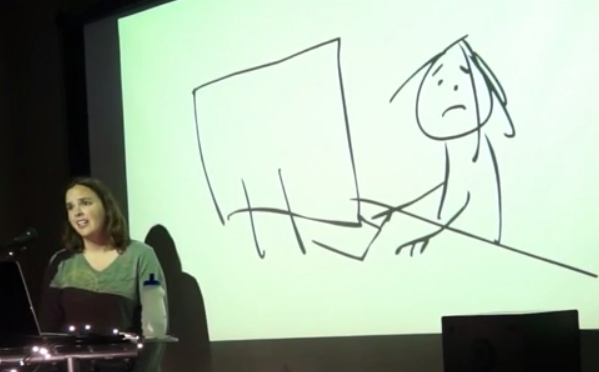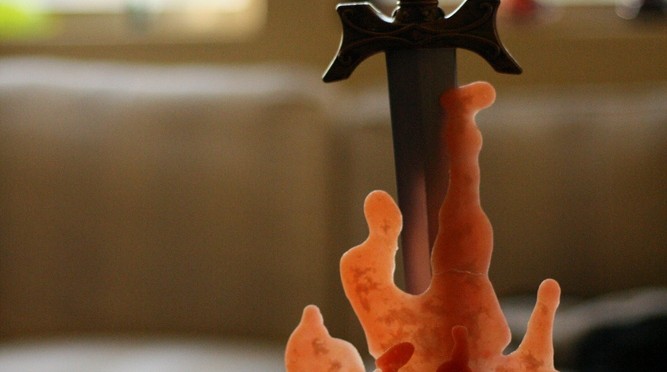I gave a talk at Glitch City Demo Night about Masterful Hugging. OR IS IT??
Tag Archives: game design
The Lisa Brown Method of Level Design
A talk I gave at Glitch City Demo Night about level design. OR IS IT?
Procedural Death Jam 2014
So I participated in Procedural Death Jam this year. Having never made a procedural game before I figured it would be a good opportunity. It was pretty fun and I was happy with my results, you can play Prop Hell here if you want to give it a try!
I wanted to go through some of my favorite entries from the Jam in no particular order. My criteria for a favorite was a game that I kept playing to the end or over and over because I found it really compelling, versus an entry I just played until I “got it.” Do note: there were many PDJ entries that I couldn’t run due to corrupted zips or executables that just wouldn’t work, but I tried my best to play as many as possible.
On Game Ideas
So, I keep a list of my game ideas as they pop up, like you do, and make sure to go back and comb through the list every now and then. Sometimes they are very much centered around mechanics, but sometimes they are very vague thoughts or phrases that I wanted to hang on to in case they would make a good game.
Often I forget what spawned these ideas. Some of them I can only remember writing down after waking up from a dream, and have since lost all memory for the context in which it relates to being a game at all. Here’s a few for your consumption:
“Ciao Ciao Ciao/Chow Chow Chow (Maybe Chow Chow Ciao?)”
“Janus loses his contacts in one face. You can only see behind you.”
“Notary Bear”
If anyone wants to make those into a game, please feel free. I have more ideas on that list than I’ll ever be able to create in a lifetime. Just let me know what you come up with because I’ll be super curious!
PH 2013 Beats
And now, a brief overview of my favorite beats from this year’s Project Horseshoe.
1. Things were already looking up on the trip to the conference at our layover in Las Vegas. I put $1 into a slot for funsies, and after a long interval of incomprehensible flashing lights, I got $15 back. This was used to purchase a victory sandwich.
2. We played Two-Truths-And-A-Lie and I managed to fool someone into thinking I had been a magician instead of a synchronized swimmer at one time in my life (the other truth was Glassblower).
3. Had wonderful conversations the first evening, which sparked that first insight about spontaneous shared experiences.
4. Next morning at breakfast, had folks play a prototype I’ve been working on and got a pile of wonderfully helpful feedback
5. Pitched the spontaneous shared experiences idea for a workgroup topic the next day and it got chosen! Many interesting conversations followed!
6. Topped the evening off with many exciting rounds of Artemis. My favorite job is Comms, where I constantly pester the Science officer for the latest gossip concerning enemy ship captains, such that I may insult them more effectively.
7. Did field research with my workgroup the next day, which involved trolling another workgroup with a cow puppet on a stick.
8. Epic potato gun battle at lunch! (no no no, this kind of potato gun, not the dangerous kind)
9. Delightful workgroup presentations that night, mine may or may not have involved a “spontaneous” appearance by G.O.B. Bluth.
10. Had the most epic stories that night playing Once Upon a Time. I love that game SO MUCH!
11. After discovering a potato in the hood of my jacket, I took revenge on the wrong person. Whoops.
Tl;dr: A good time was had by all! The only downside is a case of classic con crud. I blame the communal M&M jar.
Spontaneous Shared Experiences in Games
So, last night at Project Horseshoe a series of interesting thoughts flittered by that I wanted to capture down. A group of us were talking about mastery, autonomy, and relatedness in games and the relatedness category struck me to share a recent observation. Some time ago my brother posted on Facebook a thread that started a conversation about spontaneous shared experiences in public transportation, and sadness for people who missed out on them in a primarily “car” society. The story was about how on a bus ride, a bright yellow maple leaf managed to drift in through an open window, and everyone on the bus stopped what they were doing to watch it. Then, talk about how delightful it was to make that spontaneous connection. Another story was about a man bringing a bag of potatoes on a train and spilling them, and everyone in the car was suddenly running around, chasing wayward potatoes and laughing.
This got me thinking about how this phenomenon shows up in multiplayer games. It’s not the same as, say, an event in World of Warcraft where everyone on the realm gathers together in one place to participate in it (something like the holiday bosses). Rather, it’s more when people are together going about their own ways, and something surprising happens at that moment to just that group of people, so that they somehow instinctively know that only they experienced it, and so it brings them close together for a moment.
An example that I extracted from my memory was a particular game of League of Legends I’d played some time ago. Now, here is an already-shared experience happening within a designed context, because we are two teams playing against one another to win. Someone on my team was playing Shen (a character who can teleport to another of his teammates anywhere on the map) and their team had a Warwick (a character who can teleport a short distance onto an enemy player, latch onto them and more or less stun them and deal damage). Warwick and Shen were off on one side of the map, and Warwick was chasing down Shen, who was low on health, to get in range for the kill. In a desperate attempt to save himself, Shen did his teleport move, which has a long (in the context of a fast paced game) animation it must perform before he actually teleports. At the very, very last moment of the animation, Warwick got within range to do HIS short teleport ability, and jumped to Shen at the EXACT moment he teleported. This meant that, through a bug, Warwick teleported along with Shen right into the middle of our team, where we of course obliterated him.
The chat lit up on both teams:
“LOLOLOLOLOLOL”
“OMG what just happened!”
“That was amaaaaaaaaaazing!’
And on and on. Even poor Warwick was laughing. It felt hilarious and wonderful, and I still remember that moment out of the hundreds of League of Legends games I have played, and tell that story to people. It was as though we all knew in that moment that we’d be telling the story of what happened to friends for years to come, and it made me feel like I had a special connection to this group of mostly strangers for a passing moment.
So, what made that moment feel so good? What made it work so perfectly? I’m going to try and break it down a little:
1. Surprise. Since it was a bug, it definitely was unexpected, and so surprised everyone.
2. Logical context. The bug made perfect sense within the context of how everyone understood the rules of these two players’ moves. Of course it made sense that if Warwick teleported onto Shen right as he teleported away, that Warwick would come along for the ride. We all knew it wasn’t supposed to happen, but what did happen made logical sense in a kind of extra layer of narrative we had for how those abilities worked. If the bug had been something unrelated to the relationship between these two abilities, like if Warwick scaled really big randomly or got stuck in his ult animation loop or exploded spontaneously, it would have been surprising, but not as delightful as what really happened.
3. Reversal. One moment Shen is in dire straits, surely about to die, and then suddenly in the act of the killing blow, it is Warwick who finds himself in an impossible situation (stranded alone on the other side of the map in the middle of the entire enemy team). Humans love a good reversal.
4. No designed intent. Because this was obviously a bug, everyone knew they were witnessing a moment that had not been “designed” for them, which somehow made it feel more authentic, and more worth remembering and sharing. If I’d been together with a group of people and witnessed a random event that had been designed into the game, I might feel surprise and delight, but I don’t think I’d feel that same shared connection with the other people who had also witnessed it.
Okay, so these spontaneous shared experiences in games are wonderful things, but can we design for them? Can we create systems that have opportunities for these things to occur that do not feel like a designed event? (Preferably but not introducing a game with bugs in it) I think when players recognize something as the result of an intentional design, it goes less from spontaneous delight and more to excavation – can the thing be dug up and cataloged away – another valid experience but not exactly the kind I need to recreate.
Do the spontaneous shared connections need to require all of these elements? No, I don’t think so. Some other stories we shared contained no reversal, for example, but shared commiseration. I don’t think this is a blueprint for what these must be, just a dissection of one in particular.
Food for thought.
My First Ludum Dare – Postmortem
Though this was my very first Ludum Dare, and the solo competition at that, I feel like it went really well for me! (My entry can be found here) I ended the weekend happy with my game and with a nice mental tiredness that was not crippling exhaustion. I’m going to write about my process and the things I think helped make this Ludum Dare a pleasant and successful experience…
The Design of Everyday Things
This is one of those books that has been on my “recommended design-related reading” list for ages. It is extremely relevant to designers of any field, game designers included, mainly in the realm of the importance of usability. Aspiring game designers, read this book!
It’s pretty interesting to read now through the lens of the future (the original was written in 1988) and seeing how the author’s predictions about the future have come true. Basically he longed for the iPhone. Thinking about electronics now compared to those of the late 80s, I wonder how many designers “grew up” on this book and came into design with usability as a priority.
Anyway, much of it was reiterating what I had learned about playtesting through other means, while providing a more systematic framework for thinking about usable design. Every time I use a public restroom now I consider whether the automatic faucets have been “playtested,” and I feel like I appreciate a well designed object much more when I run into one. I also finally learned what those weird little gates are in stairwells that lead to the basement level.
Thoughts on Okami
People who know me well know that Okami is my favorite game of all time. Recently, when playing through the HD release, I found myself at a particular moment in the game just before I had to stop playing to go get dinner with Nick. I was turning in a side quest, and was mentally time managing what I was going to do next – “I think before doing the next story quest I’m going to train up at the dojo on my way back to Shinshu Field and get the clover that I couldn’t get before, but I need to go to a shop and get more seed because I missed some birds back there. I wonder if I should farm up demon fangs and get that mirror teleport now or wait until after I do the next dungeon…”
It struck me how excited I was about doing ALL THE THINGS in that game. This is unusual for me, because in most games of this nature I tend to be a primary-path sort of girl. Even in Zelda games, which I enjoy very much, I’m never too concerned about finding all the heart containers or whatever. So I got to thinking, what is it about Okami specifically that makes me so excited about doing all the collections and side quests and essentially 100%ing the game?
Theory 1:
In many games, the story artificially drives my sense of urgency. I’m talking about when the story is like “oh no we must rush to the castle before it is too late!” My logic brain knows that I could go out and farm for experience, complete the secret side quest in the first area, AND finish the entire chocobo minigame series or whatever before going to the castle (and when I got there I’d still arrive just in the nick of time).
However, emotional brain doesn’t quite understand this. Emotional brain feels I need to book it to the castle as fast as I can, because something very serious is at stake. I think my tendency is to let myself get engaged in the experience to the point where emotional brain is sort of guiding things, so I readily go from story point to story point.
In Okami, the story has a lot of exciting moments, but when you get to a new place it tends to frame things as not being in too much of a rush. Your companion, Issun, will be like “you’re gonna love exploring the city, there’s so much to do! I guess we should investigate the weird thing about the queen at some point…but the city is so happenin!”
It is an ever so slight encouragement to do whatever the hell you please, framing the next story point as “yeah, we’ll get around to it.” Possibly this setup sets emotional brain at ease, and makes me much more enthusiastic about feeding all the bunnies along the coastline before actually going into the city.
Theory 2:
It’s possible that the only thing compelling me to do so much of the extra stuff in Okami is that I’m so starved for a game experience that speaks to me. I know in the back of my mind that it’ll probably be over 10 years before someone else makes a game of this scope with this amount of whimsy and personal Lisa Brown appeal, so I become desperate to squeeze every last drop out of the experience before leaving it.
What about you, internet? What games compel you to do all their extra things when comparable games do not?
Resistance 3 inspiration images
I thought some people might find this interesting.
When I was first assigned the boat level in Resistance 3, we had a very vague idea of what it was going to be. I'd been thinking about a mostly standard ride-down-the-natural-river experience until one of the concept artists did some drawings of a boat floating through a flooded city. Immediately I thought of my hometown of Louisville, KY, and the great flood that devestated the area in the late 30s. My good friend, Scott, had a scrapbook of newspaper clippings about the flood, and generously lent it to me to bring back to California and share with my team as a source of inspiration. The environment artists were delighted! Here are a few of the more influential newspaper clippings that inspired us.
Google+: https://plus.google.com/u/0/photos/102954115822334585421/albums/5790481371840515313
Facebook: http://www.facebook.com/media/set/?set=a.591872072054.2047400.59300542&type=1




